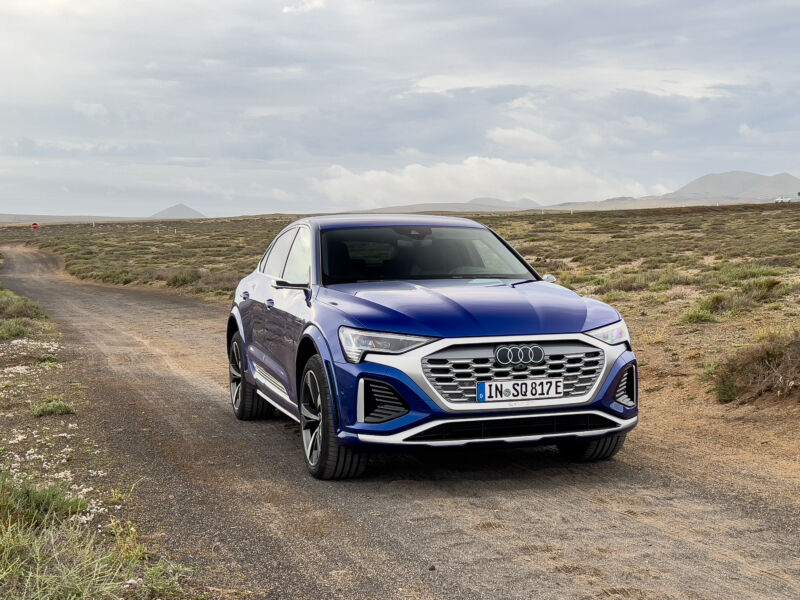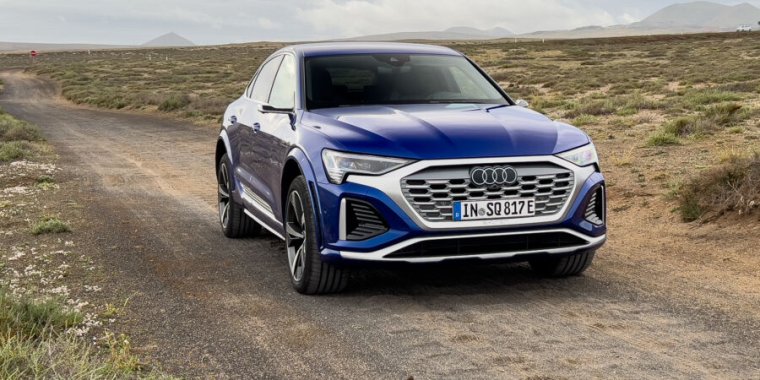
Jonathan Gitlin
LANZAROTE, SPAIN—The electric vehicle market is still nascent enough that most models are in their first flush of youth. But prevailing wisdom in the industry is that a model should live for about eight years, with a midlife spruce-up or refresh scheduled around year four. Not coincidentally, it’s been about four years since Audi started the production of its first electric SUV, the e-tron, and since then, it has gone on to sell more than 160,000. Now the German automaker has a growing range of EVs, and “e-tron” has been converted from a proper noun to an adjective in its corporate lexicon in the same way “quattro” did several decades before. So this midlife refresh includes a name change—e-tron becomes Q8 e-tron, making plain the rather obvious similarities between this EV SUV and the gas-burning Q8.
When I drove the original e-tron in 2018, I found it solid, if a bit unspectacular. It hit most of the right notes in terms of appearance—Audi knows how to design a handsome shape, and its interiors are at the head of the class, if sometimes a little somber. Developed in rather a short amount of time, the e-tron could only manage a relatively mediocre 2.2 miles/kWh (28.2 kWh/100 km) at launch. That was sufficient for a range of more than 200 miles (321 km), but not much more, although a software update in 2021 increased the useable capacity of the 95 kWh battery pack from 83 kWh to 86 kWh.
-
Audi is good at designing handsome SUVs, and the Q8 e-tron is no exception.
-
The original e-tron SUV was a convincing alternative to the gasoline Q8, but poor efficiency and limited range meant it was probably a second car. The refresh fixes that.
-
Here you can see the Q8 e-tron in its second-highest ride height as the car is in all-road mode.
-
As five-seat luxury SUVs go, this one is not bad.
-
With this refresh, Audi has brought the EV’s badge into its current naming scheme.
Although Audi is still waiting to finalize its EPA numbers ahead of the Q8 e-tron arriving in the US next year, it says it expects the longest-legged version to come in with a range of at least 300 miles (483 km). This will presumably be the lower-drag Sportback, which returns as a body variant.
It required quite a few changes to get there. For starters, there’s a new battery pack between the axles. It has the same dimensions as the old battery, but Audi has changed both the type of cell—now prismatic instead of pouch—and the chemistry, which was nickel-manganese-cobalt but is now nickel-cobalt-aluminum.
The percentage of cobalt is significantly reduced, and Audi says that combined with new battery management software, the changes mean a 20 percent increase in energy density. As a result, US-market Q8 e-trons now pack a total of 114 kWh, of which 106 kWh is useable.
The new pack also fast-charges more quickly than before. It can accept a peak charge of 170 kW, up from 150 kW in the old model, and the charging curve has been optimized to maintain high power rates for as long as possible. Audi told us that fast-charging from 10 to 80 percent should take 31 minutes, and the Q8 e-tron now features ISO 11518 or plug-and-charge capabilities.
-
The updates to the interior are minimal, but there’s an increased use of recycled materials now.
Jonathan Gitlin -
Audi’s Virtual Cockpit display is standard equipment.
Audi -
There’s plenty of room in the back for adult-sized passengers.
-
You can store 20 cubic feet (569 L) of cargo back here with the rear seats in use.
Jonathan Gitlin -
The maximum cargo capacity is 58 cubic feet (1,637 L) with the rear seats folded flat (unlike in this photo).
Jonathan Gitlin
There’s a new rear electric motor for the twin-motor, all-wheel drive powertrain, too. Audi continues to use asynchronous electric motors here rather than permanent magnet motors, due to the former’s advantage in terms of drag when not being energized. The Q8 e-tron has moved from 12 to 14 windings around the stator, which generates a stronger magnetic field for the same input of current.








